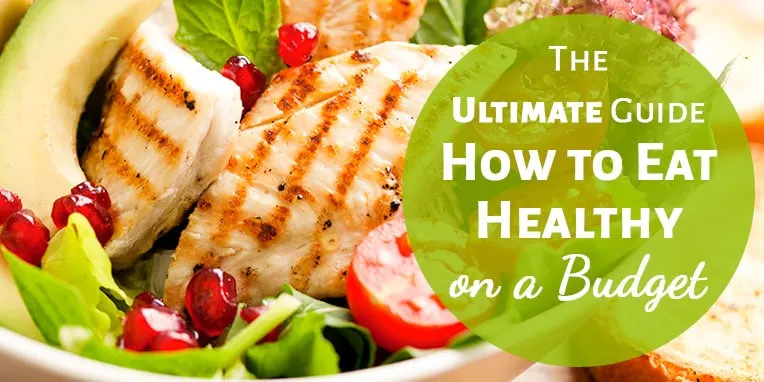
I firmly believe that you can stick to a grocery budget and eat healthy. It does not have to be a one or the other situation!
Now let me be clear — to stick to certain kinds of diets, you will most likely spend more than the average person. However, that doesn’t mean you can’t save money or that you should throw the idea of a grocery budget out the window.
We spend around $70 per week for groceries for two adults and I was able to lose weight and eat healthier than ever last year, so I know it’s possible!
So let’s get into a whole bunch of tips on how to eat healthy on a budget.
The Ultimate Guide: How to Eat Healthy on a Budget
Meal Plan
You know I can’t mention saving money on food and sticking to your grocery budget without talking about meal planning.
If you’re trying to eat healthier, don’t just buy a bunch of random healthy things at the store. You need foods that go together or you’ll have tons of ingredients that you can’t make anything with.
When I make my grocery list for the week, I also make a separate list of all of the meals that I’m going to make with the food I’m buying.
You can get the meal planning printable I use each week by entering your info below!
[convertkit form=830245]
Make Healthy & Inexpensive Food Swaps
Protein Bars ⇒ Hard Boiled Eggs
I was buying Austin protein bars for snacks at work. They seemed like a good, though expensive, option because they’re filling.
A few months ago we started paying attention to how much sugar we were eating. I was pretty shocked to find out that the protein bars, which seemed to be healthy, had a whole lot of sugar in them!
Austin, being the healthy eater that he is, said that he didn’t want me to buy them anymore. I decided that hard boiled eggs would be a great substitute. They’re naturally sugar free, a great source of protein, and super inexpensive.
I’ve been making a batch of hard boiled eggs a few times per week and we’ve both been eating them for snacks.
Soda ⇒ Sparkling Water or Drink Boxes
Yes, I know, I could substitute soda for plain ole water and that would be free. However, I like to have a fun, non-water drink everyday at lunch.
Austin and I have both worked hard to kick our daily soda habit.
It turns out that he really just liked the carbonation. He’s been drinking sparkling water instead. Aldi has their own brand of the La Croix water that literally only contains carbonated water and flavors, no sugar or fake sugar. It costs about the same as soda, so while we’re not saving a ton of money, it is much healthier.
I, on the other hand, am addicted to the sugar part of soda. I’m trying to consume less sugar, so I’ve substituted my daily soda for a daily drink box. It’s has about a third as much sugar and is quite a bit cheaper!
Chips ⇒ Popcorn
I’m not much of a salty snack person, but Austin is. Bags of chips blow a grocery budget so fast without giving you any nutrition or filling you up.
Instead, we buy popcorn. It’s still a salty snack but it’s far less expensive and healthier too. You can buy the microwave kind or cook it on the stove. The stove top method is definitely the least expensive.
Sometimes you just want to munch and munch and munch. Popcorn works great for that!
Dessert ⇒ Coffee with Cream
I figured out this healthy little cheat and it’s a game changer for me. I have the most ridiculous sweet tooth and always want ALL THE DESSERTS in the evening when we’re hanging out.
Lately, I’ve been brewing myself a cup of decaf coffee with a solid amount of creamer in it. The sweetness of the creamer satisfies my sweet tooth without giving me near as many calories as a full dessert.
Since desserts can get expensive, it’s saving money too . My cup of coffee with cream only costs a few cents!
Deli Meat ⇒ Boneless Skinless Chicken Breast
Deli meat is so pricey! We’re talking at least $3 per pound. That, along with recent studies about how harmful processed meats can be, means that we hardly ever buy it anymore.
Instead we cook large batches of boneless skinless chicken breast to put in sandwiches, salads, and casseroles. I can get chicken for less than $2 per pound. The chicken has fewer calories, less sodium, and no preservatives. #winning
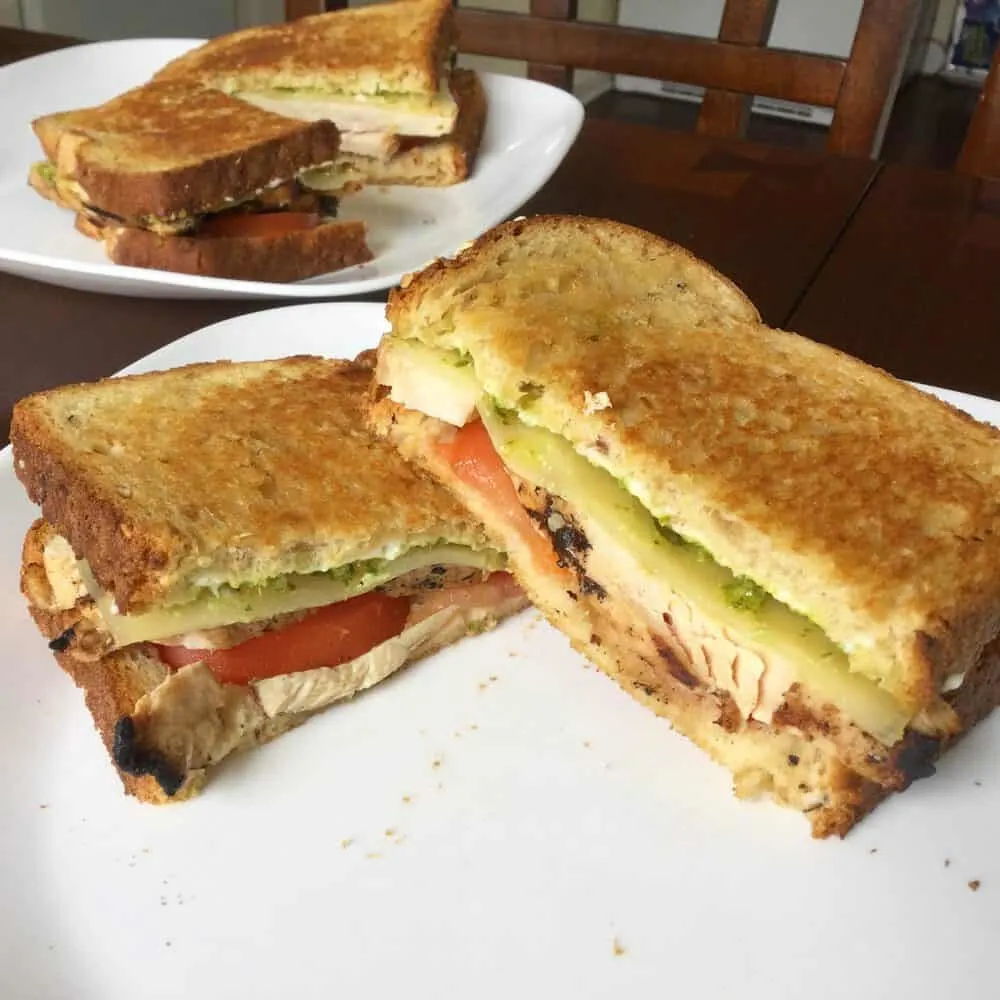
Make Meals that Center Around Inexpensive Ingredients – 24 Foods Under $1 Per Serving
None of these foods makes an entire meal by itself, but if the majority of your meals are made up of these ingredients with some extras added in in small quantities, you’ll be eating balanced meals for a low price.
A few examples meal combinations would be:
- Chicken Stir Fry: Frozen stir fry veggies(#14) with the sauce included plus boneless skinless chicken breast(#2) and rice.
- Chicken Wraps: Boneless skinless chicken breast(#2) in a sandwich wrap(#22) with green pepper slices(#12) plus a little ranch dressing, shredded cheese, and hot sauce.
NOTE: I’ve listed the price per serving next to each food. My prices are based off of what I can find in my area. I know prices vary by area and not everyone has an Aldi nearby. Even if your prices are higher or you don’t have Aldi where you live, I think you’ll find that these foods are still inexpensive options compared to other foods.
1. Eggs: 6¢
Eggs are an extremely inexpensive way to get protein. I have a few eggs over easy with a whole wheat mini bagel for lunch throughout the week. We almost always have hard boiled eggs on hand for a snack as well.
2. Boneless Skinless Chicken Breast: 50¢
This is one of the least expensive meats in our area. It’s the meat we eat 95% of the time because of that. We have it in wraps, soups, and quesadillas often. Pay attention to your serving sizes here. A serving of meat is around 4 ounces, yet the chicken breasts we get can be up to a pound each!
3. Salmon: 95¢
While salmon isn’t super cheap, we have found that the price really isn’t too bad if you buy it frozen. It’s extremely filling so we don’t find ourselves overeating with it. We cook it either in a skillet or on the grill with some lemon pepper seasoning (super simple) and serve it with roasted veggies. I always use my meat thermometer when I cook salmon so that I don’t under- or over-cook it.
4. Beans: 20¢
I’ve been gradually trying to eat more beans because of how inexpensive and healthy they are! You can read some of my favorite strategies for getting yourself to eat more beans (or tricking your family to eat more beans 🙂 ).
5. Homemade Hummus: 49¢
Hummus at the store isn’t cheap. Luckily, it’s super easy and inexpensive to make yourself! You literally just blend everything like crazy until it’s smooth. Here’s my go-to hummus recipe.
6. Sweet Potatoes: 25¢
You can heat sweet potatoes up in the microwave and eat them like a baked potato. Our favorite way to eat veggies in the winter is to chop sweet potatoes, onions, and carrots and roast them in the oven. Just drizzle olive oil on them and sprinkle salt, pepper, and garlic on top. Bake in a single layer on a pan for 30-40 minutes at 450°, flipping halfway through.
7. Carrots: 20¢
Raw or roasted!
8. Onion: 15¢
Onions are very inexpensive and can be a good addition to any meal.
9. Potatoes: 20¢
We most commonly roast these in the oven, though there are a million ways to eat potatoes.
10. Broccoli: 22¢
Austin puts raw broccoli in his salads which is very filling. We buy a lot of frozen broccoli because it’s so inexpensive and easy to cook in the microwave for a few minutes for a healthy side dish.
11. Cucumber: 23¢
We go through a lot of cucumbers. Such a yummy snack.
12. Green Pepper: 28¢
In salads, for a snack, sauteed with scrambled eggs…
13. Pumpkin: 25¢
I bake with a lot of canned pumpkin. It’s inexpensive and very filling. Pumpkin wheat pancakes, chocolate pumpkin muffins, pumpkin bread… It adds some nutrition to baked goods.
14. Frozen Stir Fry Veggies: 31¢
Frozen veggies of all kinds are so convenient to have on hand and they go on sale regularly. We keep a bag of frozen stir fry veggies on hand because it makes for a quick dinner. The bag includes stir fry sauce and we can throw in some leftover chicken to make a full meal in 10 minutes.
15. Bananas: 22¢
We put bananas in smoothies a lot. They make a great snack too
16. Apples: 31¢
We put apples in lunches or slice them for a side dish at dinner.
17. Pears: 44¢
I can’t get enough pears! Fresh pears for lunch, a side dish, or a snack. Canned pears are great in smoothies.
18. Applesauce: 18¢
Natural applesauce (without sugar added) makes a great snack or side at dinner.
19. Wheat Mini Bagels: 16¢
Aldi has whole wheat mini bagels and I’m in love with them. They’re good with breakfast of course, but I also dip them in soups or spread them with a little peanut butter and nutella to satisfy my sweet tooth.
20. Whole Grain Tortilla Chips: 22¢
These do cost a bit more than regular tortilla chips (though not too much more if you shop at Aldi). They’re so much healthier and more filling though, so I find them to be worth it.
21. Whole Grain Frozen Waffles: 26¢
Around here, the whole grain frozen waffles go on sale along with regular frozen waffles, so they’re not any more expensive! They have a bit of a different texture and flavor depending on the brand, so it’s good to find out which brand you like the most. They make for a quick breakfast, either with a little syrup or spread with some peanut butter.
22. Sandwich Wraps: 33¢
We don’t eat many sandwiches because we try to avoid lunch meat. We do like to use sandwich wraps and leftover chicken to make chicken wraps. The sandwich wraps are generally fewer calories than two slices of bread would be.
23. String Cheese: 16¢
Sam’s Club has giant packs of string cheese for a good price. We like to have it on hand to put in lunches and for a quick snack.
24. Peanut Butter Powder: 17¢
We recently discovered peanut butter powder! There are not weird ingredients in it and it literally has 90% less fat and 1/3 of the calories of normal peanut butter, mostly because there isn’t tons of oil in it. You can mix it with a bit of water to spread it on something but we most often use it in smoothies because it’s so easy to add a scoop of powder to the blender. You can find it for the best price in large containers at Sam’s Club or Amazon.
Cut Back to One Soda Per Day
In my effort to consume less sugar, I started by cutting back to one can of soda each day. After I had that habit down, I changed my one soda per day to one drink box per day since it had less sugar.
Gradually cutting back has been a great success for me. It’s saving money too!
Eat Simply
Fruits & Veggies
You don’t need fancy side dishes. Simple and healthy means easy-peasy plain fruits and veggies.
To save money, buy fresh if the fruits and veggies are in season or on sale. Buy frozen or canned if they’re out of season.
Focus on getting a serving of fruit or a serving of vegetables at every meal. If you’re feeling snacky, go for these before anything else.
We try to make sure that we have at least one kind of fresh fruit available each week as well as one kind of fresh vegetable for snacks. So we might buy a bag of pears and some fresh cucumbers to munch on.
Then we can warm up some frozen veggies, like broccoli or green beans, to go with dinner.
If we want smoothies in the winter, we’ll get a bag of frozen strawberries since they’re out of season.
Main Course/Meats
We keep our main courses and meats simple to save money while eating healthy.
First of all, meat is expensive, so we try to stretch it as far as we can. Here are some of the ways we do that:
- We add beans to tacos and quesadillas so that we can use less meat. They’re inexpensive, filling, and so good for you. We love the fat-free refried beans from Aldi.
- Add a little chopped ham to a salad and baked potato meal.
- Soup! A small amount of meat, whatever veggies you’ve got and some broth.
- Stir Fry. You can get a huge bag of frozen stir fry veggies that includes the sauce in the freezer section of the grocery store. Cook up a batch of rice and add a little chopped chicken, shrimp, or beef for a healthy and inexpensive meal.
- The Platter. This is Austin’s specialty. He uses all of our fresh leftovers to make an amazing meal platter. Bits of meat, cheese, veggies, and whatever else he can find becomes a mini feast.
When meat is the main course, don’t get sucked into complicated recipes. Simple is healthy.
Chicken
We buy boneless, skinless chicken breast in bulk when it’s on sale (less that $2/lb). I freeze it all in 1-2 lb portions.
The easiest and most delicious chicken recipe I know is to marinate it overnight in balsamic vinaigrette salad dressing and then grill it. That’s it. You won’t believe how good this tastes.
To stretch the chicken, we chop it up and use it in wraps, quesadilla, on soup, or casseroles. If we eat it plain as a main course, we make sure to have large portions of vegetables and rice with it.
Fish
We’ve been eating a lot of fish and I’m shocked at how fast and easy it is. I can make a dinner in less than 15 minutes when we have fish. Plus, it’s so good for you!
If you aren’t normally a fish eater, you’ll probably be surprised at how filling it is. I know the price per pound can seem high, but we feel fuller on small piece of fish compared to the same size piece of chicken or beef.
Frozen tilapia is what’s most cost effective to buy around here. I usually buy a big bag from Aldi or Sam’s Club. We buy frozen Salmon if we’ve got a little extra money.
Once it’s thawed, I simply cook in on the stove with a teaspoon of olive oil and some seasonings. Lately, we’ve been using a lemon pepper seasoning. While the fish is cooking, I microwave some sweet potatoes.
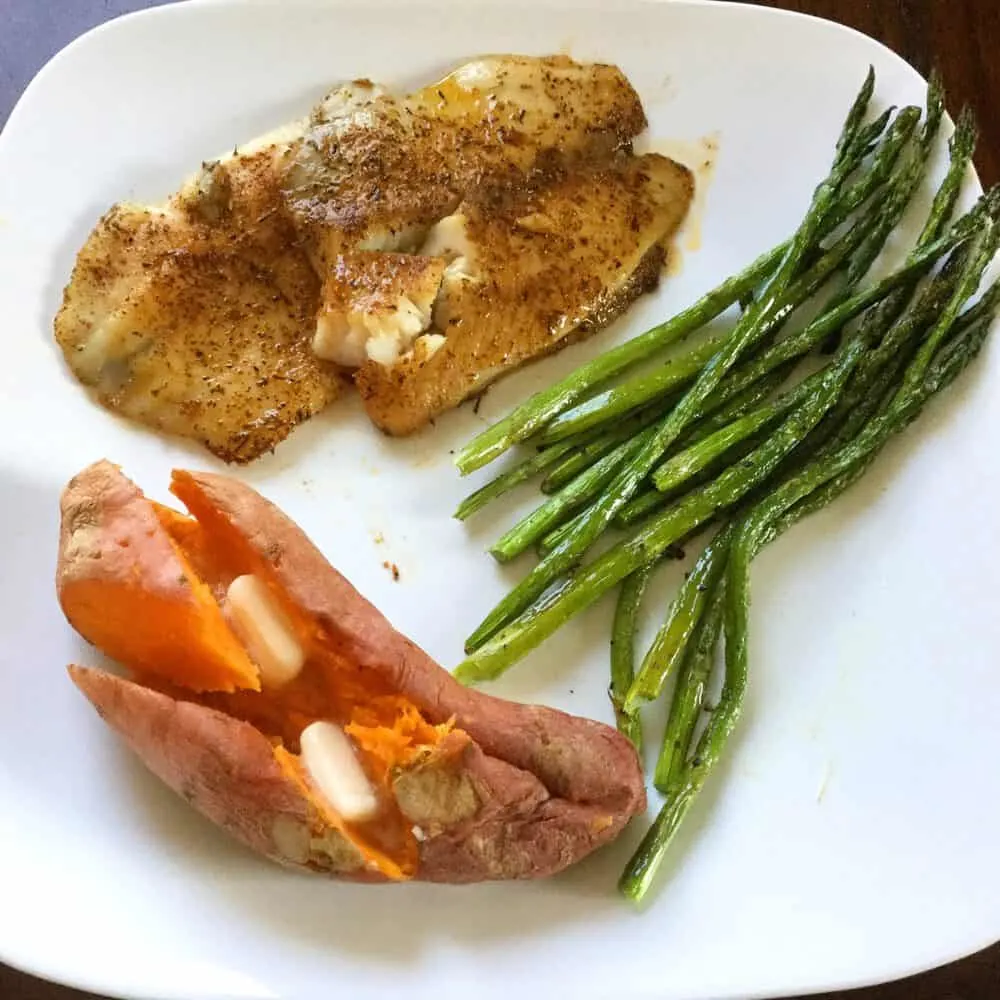
Skip Specialized Ingredients
I’m cautious about buying all kinds of new specialty ingredients. I could blow my budget in a heartbeat buying chia seeds, goji berries, and organic flaxseed.
If I want to try some new healthy ingredients, I take them one at a time. I purchase one and try it a few different ways to get used to cooking with it and eating it.
Most of our meals center around the same group of ingredients. I know that if I try a recipe that is completely different from what we normally eat, there’s a smaller chance that we’ll like it, and we’ll have to spend extra money buying all kinds of ingredients that we don’t keep on hand. That’s a big reason why I try to add in new ingredients one at a time.
Set a Budget
I’ve heard people make excuses for not having a grocery budget because they’re on a special diet or trying to eat healthy. The two are not mutually exclusive!
You may have a higher grocery budget, but you still need a budget.
Setting a budget will make you more aware of what you’re spending, help you prioritize where to spend the bulk of your money, and give you motivation to seek out sales or less expensive options.
It might take a few tries to figure out what your budget should be if you’re new to budgeting or have started eating differently, but don’t use that as a reason not to work at spending your hard-earned money as well as possible.
For instructions on how to create your first monthly budget, click here.
Shop Only Once a Week
Shopping once a week can save a lot of money.
Every time you stop for one or two things, you’re likely to grab a few extras that weren’t on your list. Those extra purchases add up very quickly and almost always end up being unhealthy treats!
Shopping once a week gives you less of an opportunity to make impulse purchases which might save you more money than you realize.
When we lived far from the stores, I would go once a month to buy almost everything I needed for the whole month. Then once a week, I would make a quick stop just to buy fruits and veggies for the week. It took some significant planning to meal plan for the whole month, but I was able to keep our grocery bill very low.
Now that we live in a bigger city, I make my meal plan for the week and only go shopping once a week.
Click here for more tips on shopping only once a week.
Keep Track of Your Spending at the Store
You might not realize how much groceries cost when you’re just grabbing your usual items and throwing them in your cart. An amazing way to save and become more mindful of what you’re buying is to calculate as you go.
Now you don’t have to walk around with a calculator and perfectly add up each item (unless you want to). Roughly adding things up in your head will help. I love the idea of using a tally counter. Just round the prices up or down and click it once for each dollar.
If you’ve got kids grocery shopping with you, they can help (education, yo!).
Fill Up On Veggies and Fruit
We’ve been making big efforts to fill up on more fruits and veggies.
If you purchase what’s in season, this doesn’t have to be expensive at all.
Plus, there are some really great frozen and canned fruits and vegetables that can be an easy part of any meal. Canned fruits and vegetables go on sale all the time, so you can easily save money on the healthy stuff this way.
The USDA recommends that half of your meal should be fruits and veggies, so try and fill half of your plate with those before you add anything else.
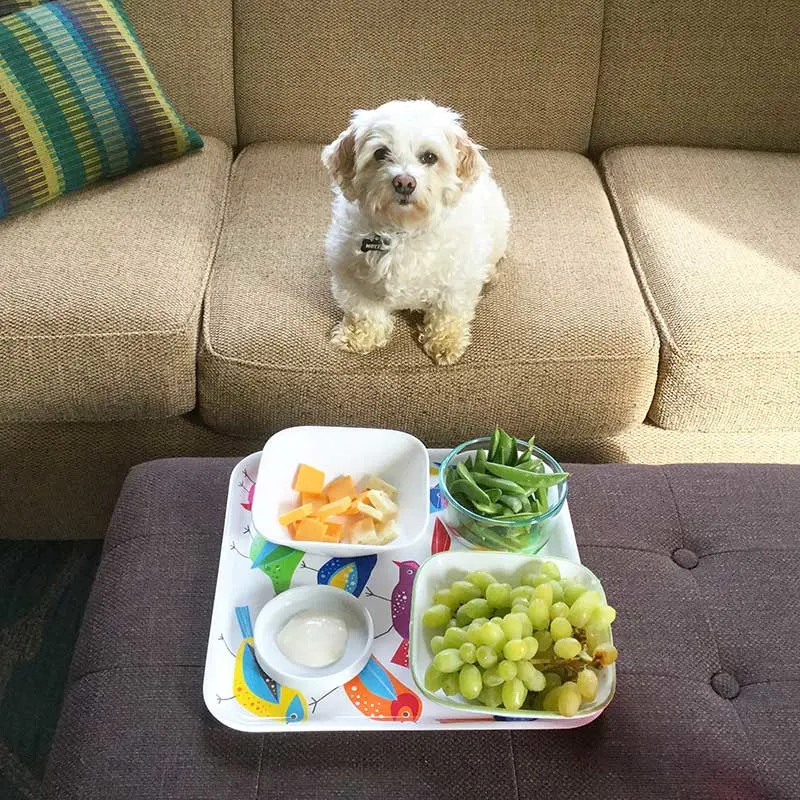
Save $$$ Without Clipping Coupons
Clipping coupons is not usually a good use of my time. Occasionally, we’ll get a newspaper that has coupons inside and I’ll browse through to see if there are coupons for anything I would normally buy.
We buy a lot of fruits and veggies and it’s pretty rare to get coupons for those.
The best way I’ve found to save extra money on food without spending tons of time clipping coupons is with Ibotta. It’s a super easy to use app that you can use on your phone or tablet.
All you have to do is glance through to see if there are rebates available (they get new ones each week) for what you are planning on buying at the store, or what you just picked up. Then you take a picture of your receipt and Ibotta confirms that you purchased that item.
You can cash in your rebates for gift cards to many different stores, like Amazon, Walmart, and Starbucks, or you can cash them in with PayPal.
Plus, they have rebates available for fruits and vegetables as well as store brand items. To quickly find these rebates, I click on the store I’m shopping at and then in the search bar, type in “any brand”. This brings up all of the items that can be purchased in any brand. So I might be able to get a rebate on any brand of milk, bananas, cereal, or tomatoes.
Click here to download the Ibotta app and start saving!
Limit Juices, Sodas, & Milk
I could easily drink my daily calories in juice and soda. I love it.
But in the interest of our finances and my sugar intake, we try to limit the amount of juice and soda we drink. I have a drink box with lunch each day (yes, I eat like a toddler). Other than that, I try to reach for water.
Milk can also be limited to save money. If you’re worried about getting enough Calcium, do a little research on this. Milk is not the best source of Calcium out there, so you can limit your milk intake if you get enough of the right veggies and beans that have even more Calcium in them.
Measure Serving Sizes
I’m shocked at how much longer our food lasts when we take an extra minute to measure serving sizes on a few things.
I love to eat cereal every morning for breakfast. I get the chocolate shredded wheat that has a lot of fiber with just enough sweetness to start my day. Love it!
Well, it’s not super cheap, but I’ve been using a food scale to measure my serving size each morning, and you know what? That box of cereal lasts a long time if I eat the correct serving size!
I know a lot of people that don’t buy cereal at all because they go through it too fast. It’s really easy to pour a bowl full and eat over twice the amount that you’re supposed to. So of course you go through it way too fast and it seems far too expensive for how many meals you get out of it.
Another area to measure serving sizes is in meat.
It’s easy to think that each person should get their own chicken breast. Well lately, the chicken breasts we’ve been getting are about a pound each!! A serving of meat is about 3-4oz. That means that each chicken breasts should be enough to feed 4 people instead of 1! That’s going to make a big difference in the budget.
We’ve recently started measuring out serving sizes for snacks as well. When we’re dying for a bag of chips or some peanut m & ms, we buy them and make sure to only eat one serving at a time.
Don’t Be Scared Of Store Brands Or Aldi
I’m so glad that most people are much more OK with saving money by buying store brands as well as shopping at Aldi.
I have honestly found that there are a great deal of foods that I prefer from these sources instead of the name brands.
There is almost nothing I don’t like from Aldi and pretty much everything is far less expensive than anywhere else. In fact, Aldi has removed synthetic colors, added MSG, and trans fats from all of their store brand products! These are higher standards than many popular name brands use which means shopping at Aldi can be better for you.
If you haven’t jumped on board with these money saving methods, here’s your invitation.
Take a look at what we buy at Aldi. (Ignore the cream cheese danish in the pic below. It was a moment of weakness.. And delicious! 🙂 )
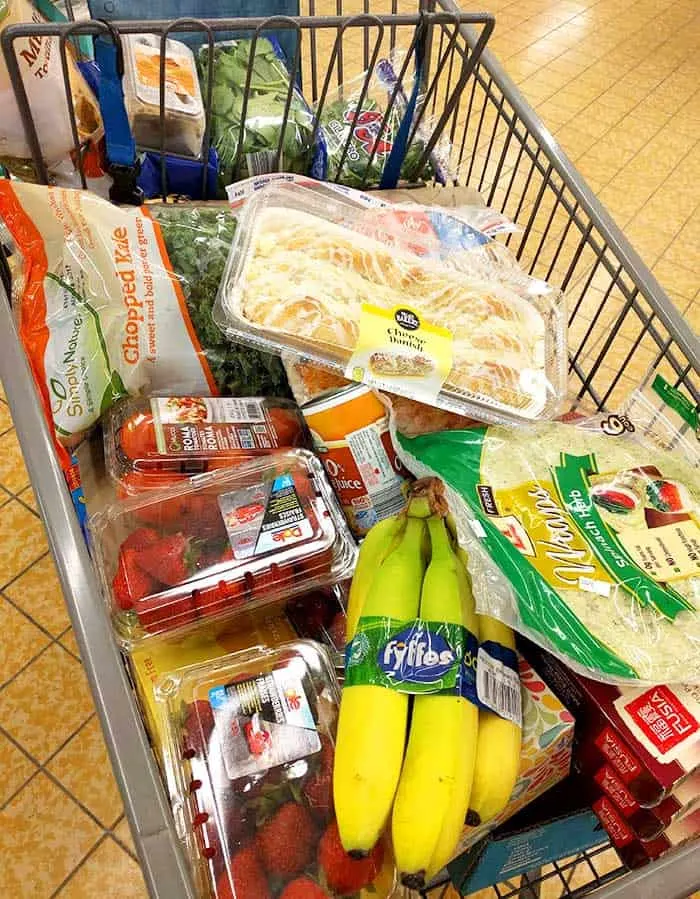
Check Sale Ads
While I’m making my meal plan and grocery list, I like to go online and check the sale ads for a few stores close by. I mainly look at the fruit, veggie, and meat sales.
I usually try to only go to two stores because I value my time and sanity. By checking a few sale ads, I can decide which stores it makes sense to go to based on how many of the things I need are on sale at each one.
Also, it’s best to plan your meals around what’s on sale instead of getting whatever sounds good. Why plan to make a roast and pay full price for the meat when there’s a great sale on chicken? This strategy will save a ton of money and doesn’t take much time.
In-Season
We eat a lot of fresh fruits and veggies.
The prices fluctuate hugely around here on fruit depending on if it’s in-season or not (veggie prices don’t change near as much). We pretty much stick to buying fruit when it’s in-season and a great price.
If something is not in-season, we might buy it canned or frozen instead.
Less Meat
Eating less meat has been helping us stick to our budget lately. Of course this strategy might not work for you if you’re eating a high protein, low carb diet. I wrote a whole post about eating less meat that you should definitely take a look at if you’re interested in this method of saving money.
We often add in more veggies or some beans so that we don’t need quite as much meat.
If you or your family doesn’t like beans, I wrote about sneaky ways to get used to eating more beans here.
Eating more eggs is a great way to get protein without meat. Eggs are inexpensive and we eat them for any meal or as a snack.
Rotate the Same Few Healthy & Quick Breakfast Options
High Fiber Cereal
I have an undying love for Chocolate Mini Wheats Little Bites Cereal. I literally eat this every day.
Healthier cereals can get a bit pricey. I use my food scale to measure out a serving into my bowl each morning. This makes the price per bowl of cereal not bad at all and keeps me from eating half the box in one sitting. With the healthier cereals that contain whole grains and more fiber, the serving size listed on the box is very filling.
Oatmeal
Quick oats literally only take 1 minute in the microwave. Sometimes we get the packets but I prefer to make it myself and add a little brown sugar.
Smoothies
Austin got on the smoothie train earlier this year. We use our Ninja to blend up a little Greek yogurt, ice, fruit, peanut butter powder and kale for his morning smoothie.
Pinterest has approximately 5 million (not an exaggeration) smoothie recipes if you need inspiration 🙂
Yogurt with Granola
You can make homemade granola ahead of time or buy a granola cereal. If you want to be able to take it to go, buy the single serving yogurts or save money with the bigger tubs.
Eggs – Scrambled or Hard Boiled
I have actually found that I can cook scrambled eggs very quickly in the morning, so we do this on occasion.
As something I can make ahead, I’ll often boil 6-8 eggs so that we have hard boiled eggs ready to go.
Mini Bagel with Peanut Butter
Aldi has whole wheat mini bagels that I adore. They’re just the right size and are filling with a little peanut butter on top.
Confession: I add Nutella too. If you haven’t tried it, peanut butter and Nutella together will change your life.
Banana Muffins
Any kind of baked goods that you can make ahead of time are a perfect “grab and go” meal. This is recipe I use.
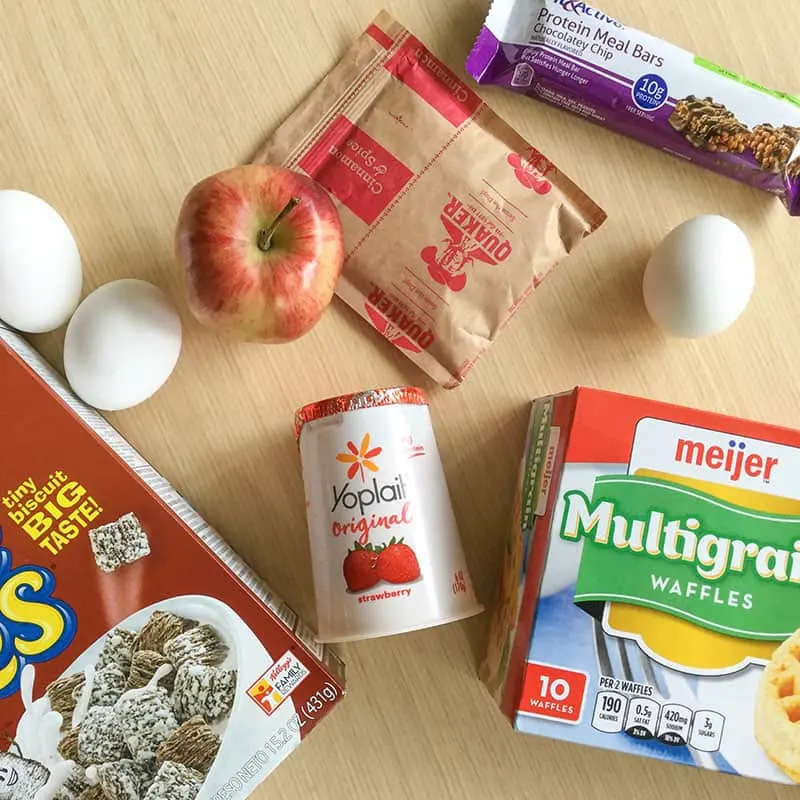
Break the Eating Out Habit! It’s Unhealthy & Expensive
Clean Your Kitchen
If you struggle with going out to eat too much, start with cleaning your kitchen. Let me explain…
If the sink is already overflowing with dirty dishes, I have no desire to add more to the mess or to try to undo the mess before I can even cook anything. It’s just too overwhelming.
It’s odd that the two things are related, but if I make a point to do the dishes and wipe down the counters at least once a day, I actually enjoy being in my kitchen and have more of a desire to cook!
Meal Plan
Always meal plan! Meal planning is simply buying the right groceries that make up certain meals.
If you know that you have all of the groceries to make multiple meals at home, it’s a lot harder to justify going out to eat. Trust me, I know.
Figure Out Dinner the Night Before
Sometimes even with meal planning, I goof things up by not thinking about dinner early enough.
If I need to thaw meat from the freezer or get everything put in the crockpot, that’s good to know ahead of time.
I try to think over what we’ll be doing for dinner the next day each night before bed. That gives me time to pull anything out the freezer or make sure I wake up early enough to throw food in the crockpot.
Pack a Lunch the Night Before
Along with planning meals the night before, aways always make your lunches the night before. If you end up being in a rush the next morning, packing lunches is probably the first task you’ll scratch from your list. This usually results in an expensive, unhealthy fast food lunch.
Just assume that you won’t have time in the morning and pack lunches the night before.
At our house, Austin packs his lunch for work as part of our regular evening routine. I know that he’d spend a ton of money eating out if we didn’t do this. Since an inexpensive lunch is around $7, that could be $140 every 4 weeks spent on work lunches — and that’s a conservative number!
Make Simple Meals
Another way to make eating at home easier on yourself is to cook simple meals.
Many times I have planned a delicious meal that was far too complicated or time consuming for my energy level. So of course, we got takeout instead!
I try to plan simple meals for most of what we eat. Things like grilled chicken with a pack of frozen veggies or scrambled eggs with sauteed veggies are regular meals at our house. They’re quick and easy so there’s no excuse not to make them.
Whew! Big list 🙂 I hope this list gives you some new ideas and helps to convince you that it is possible to eat healthy while on a budget. You can also read my top 10 tips to eat healthy on a budget.
Now I would love to read any of your tips! Please leave a comment of any tips you have for how to eat healthy on a budget below.
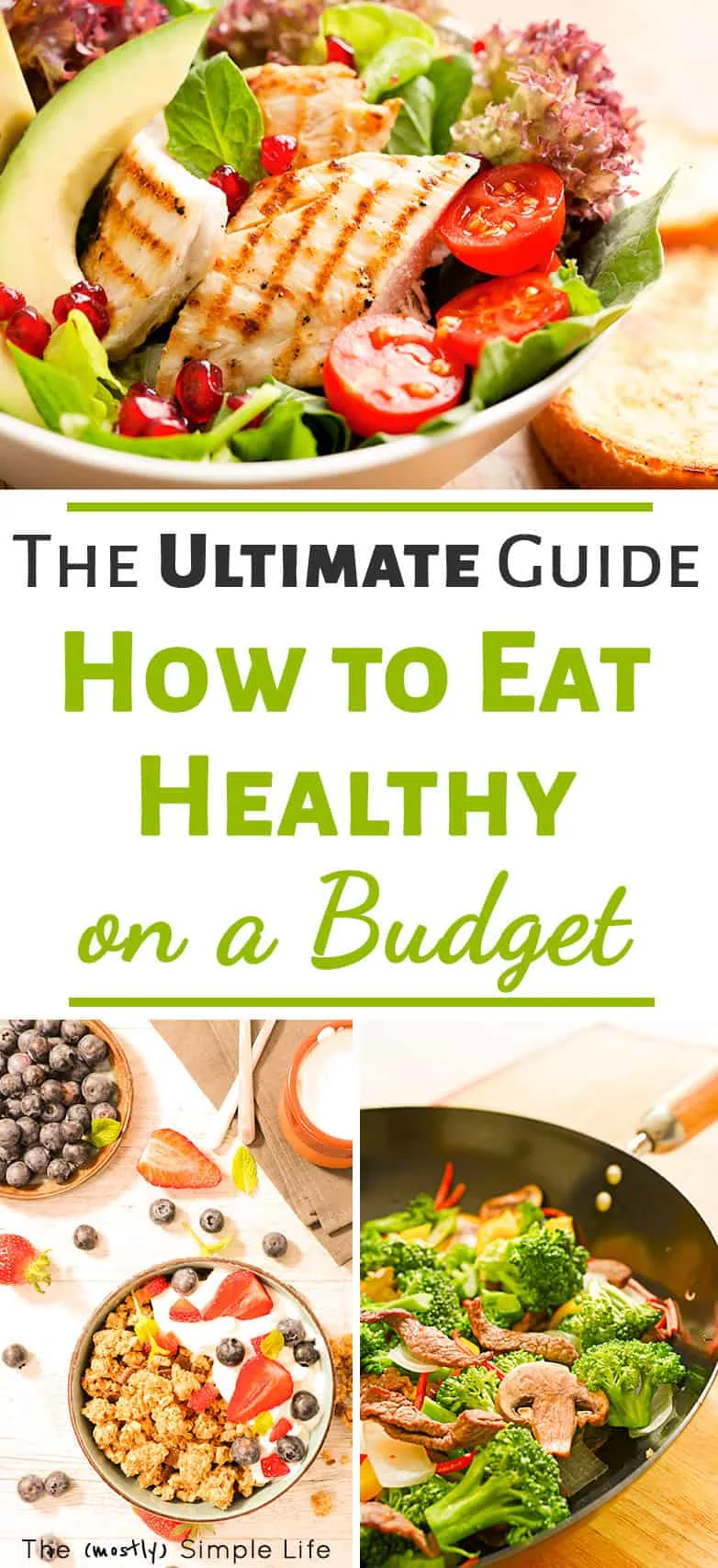

13 Ways To Not Spend Money - The (mostly) Simple Life
Thursday 25th of January 2018
[…] The Ultimate Guide: How to Eat Healthy on a Budget […]
Maryam
Thursday 18th of January 2018
What a great post. You’re right that we tend to get bogged down with complicated recipes when trying to eat healthy. Simple food is always best.
Christine
Friday 19th of January 2018
Thanks so much Maryam!